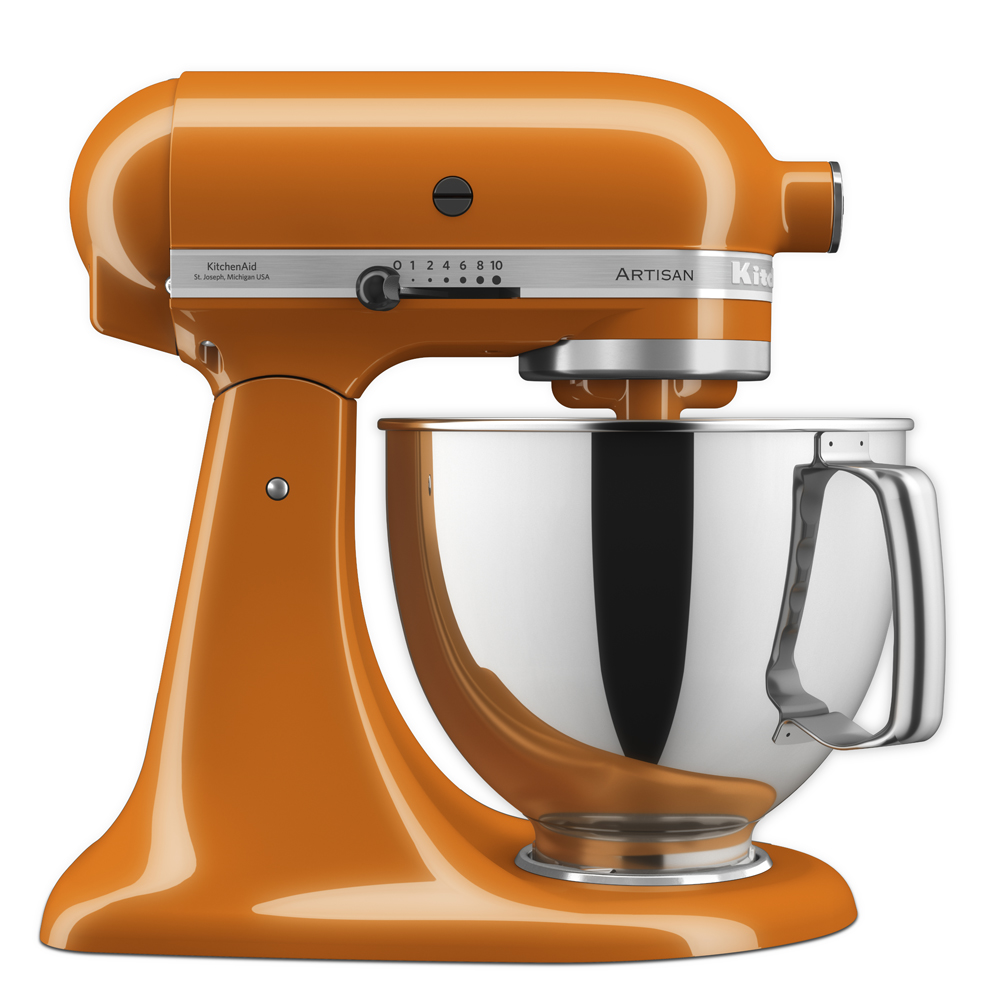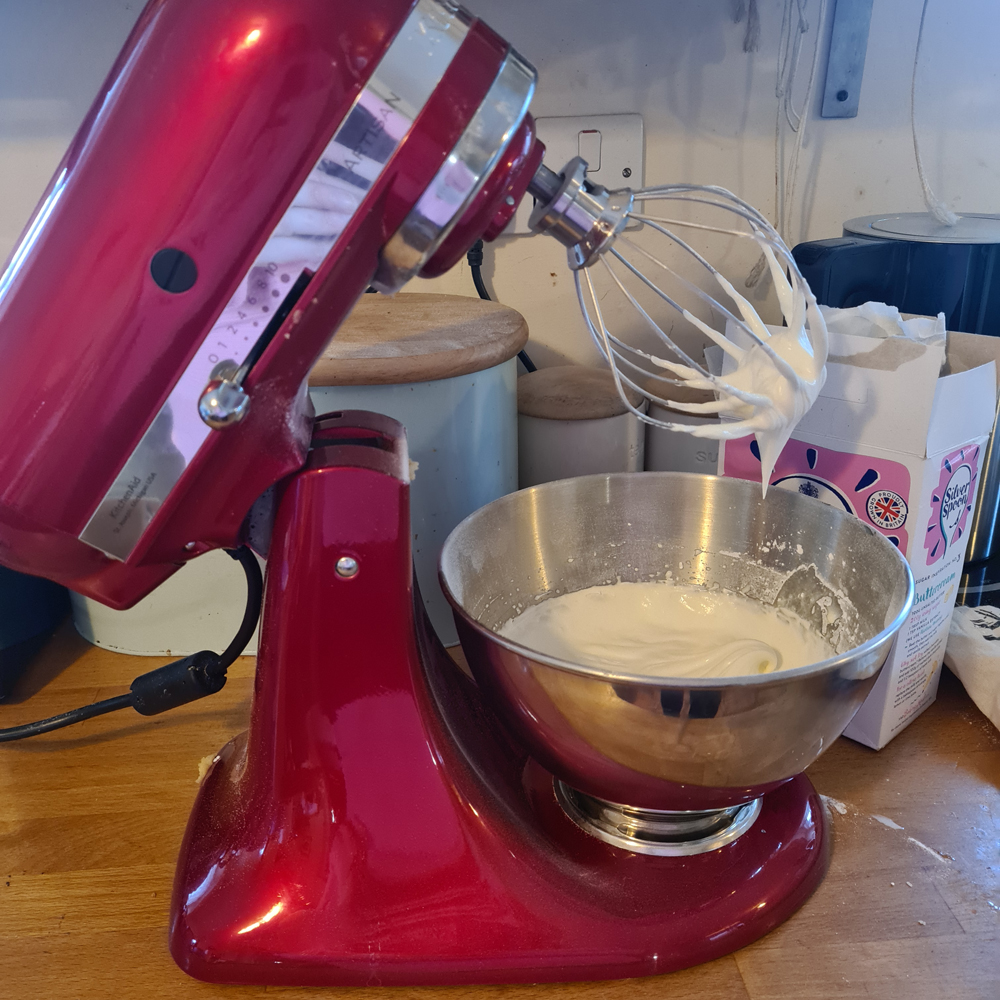KitchenAid Artisan mixer review - is this kitchen classic a star baker?
The KitchenAid Artisan is perhaps the most iconic stand mixer you can buy, but after 100 years, how does it compare to the competition?

With a sturdy make and plenty of design options to choose from, the KitchenAid Artisan mixer is ideal for houseproud hobby bakers. For bread makers, you may need something more powerful.
-
+
Its iconic look
-
+
The reliable metal frame
-
+
Easy to clean
-
+
So many colour options (with plenty of matching appliances available)
-
+
Expand its functions with additional attachments
-
+
Covered by a five-year guarantee
-
+
Durable enamel coating
-
-
It weighs a hefty 11kg
-
-
With only 300 watts, it’s not the most powerful
-
-
I wasn’t confident with its dough kneading
Why you can trust Ideal Home

From the Great British Bake Off to Nigella’s hot pink kitchen, it’s unlikely that you’ve not seen or heard of the KitchenAid Artisan stand mixer. Not only is it a real looker, but it is also one of the most multi-talented stand mixers you can buy, making it a popular choice with both home chefs and house-proud novice bakers. Its reputation proceeds it, but is the KitchenAid Artisan worth the hype?
I’ve got plenty of experience when it comes to reviewing the best stand mixers, which means you’ll always find plenty of fresh cake and bread in my kitchen. Mixers keep getting smarter these days, so in this KitchenAid Artisan review I was keen to find out if (after 100 years in the biz) the KitchenAid really is the top dog. I put it through its paces over the course of a weekend, using it to knead dough, whip cream and beat cake batter. My verdict? It’s hard not to love the KitchenAid Artisan, but it’s not without fault. For my full KitchenAid Artisan review, keep reading.
KitchenAid 4.8L Artisan Stand Mixer

KitchenAid Artisan product specs:
Size: H36 x W24 x D37
Bowl capacity: 4.8 litres
Speeds: Six
Colours available: Well over 30
Cleaning: Bowls and attachments are machine washable
What’s in the box?
My KitchenAid Artisan sample arrived as a deluxe pack, meaning it came with a regular 4.8 litre mixing bowl, a shallower and handle-free 3 litre stainless steel bowl, as well as a flat beater, dough hook, 6 wire whisk, and pouring shield. If you don’t buy the Artisan Premium and opt for the regular Artisan (which at time of writing is £100 cheaper) you’ll get the same machine but with the hook, whisk and larger bowl included.
Getting your KitchenAid Artisan onto the kitchen counter is going to be a struggle. It’s hefty, weighing over 11kg in total, which is down to the quality solid metal body. The sturdiness of this mixer is very attractive, and I was filled with confidence that it would be able to handle anything I made in it without damage. If you’re considering buying the KitchenAid Artisan, the appeal of sitting it on your kitchen counter is surely part of the attraction, so I doubt you’ll mind that it’s difficult to move. If you are short on counter space and just want something to get the job done before storing it away, this isn’t the machine for you. The Artisan is a beauty, and it would be ludicrous to store it in a cupboard away from sight.
What is the KitchenAid Artisan like to use?

I always do the same recipes when testing stand mixers, which include (but are not limited to) a victoria sponge filled with fresh whipped cream, and a loaf of white bread. That way I’m able to test the most common stand mixer attachments - whisk, flat beater and dough hook. Right off the bat, I’ll admit that despite any critique I have of the KitchenAid Artisan, the results were some of my finest. The sponge cake was fluffy and light, but very well mixed, the cream was stiff but not too firm, and very evenly whipped, and my bread dough rose wonderfully.
The mixer is easy enough to use. It’s a tilt-head, meaning you need to pull a lever to the side of the machine to lift the head and switch out attachments or remove your bowl. Because this is symmetrical to the controls on the other side, I did accidentally turn the mixer on when trying to lift the head, but after some use you should be able to tell the right one without thinking.
The controls themselves come in a scale of 1-10, but when clicking along it’s apparent that there are only six actual speeds. These go up in twos, and the handbook advises you to use certain speeds with specific tasks.
Making bread in the KitchenAid

To make bread in the KitchenAid Artisan, use speed 1 to combine ingredients and then 2 to knead. You’re advised not to go above 2 as it could damage your mixer. Even on setting 2 though, I found that the mixer moved around my kitchen counter more than I expected. For such a heavy machine with a sturdy metal construction, I did not expect it to have any trouble kneading, but I suspect the 300 watt motor (which is below the industry standard) may have struggled to knead the quantities I used. I made two loaves, which is advised as the maximum amount you can do in any one go using the KitchenAid Artisan.
To its credit, the dough came out wonderfully when kneaded in the Artisan. I wouldn’t have felt comfortable leaving it unaccompanied thanks to how much it moved around my counter, but it didn’t take long to bring the mix together and produce a smooth and glutenous dough that had plenty of fibres and stretch to it. The dough was also warm to touch after five minutes of kneading, which is a good sign that the yeast has been activated and is doing its job.
Although stand mixers can come with as much as 1200 watts these days, you don’t need this much unless you’re in a professional kitchen. If you like to bake bread but it’s not your primary motive in buying a stand mixer, I’d recommend the Artisan for you. Its motor isn’t bad at all, but if you want to use it purely for kneading dough, going for something with a bit more muscle will pay off.
Making cake in the KitchenAid Artisan

I really enjoyed how my cake came out when I tested the KitchenAid Artisan. It was able to integrate all my ingredients well, but definitely did a better job when more full. I started off by creaming butter and sugar together, and found that the flat beater left a little of this mixture at the side of the bowl. Most stand mixers do this, and it’s just a case of going in with a spatula to scrape off anything that hasn’t mixed in when your dough is assembled.
When adding the eggs and flour I found the bowl was deep enough to not need the shield (although with icing sugar I’d definitely recommend it) and it brought together a well-beaten but not overworked cake batter in a relatively short amount of time.
Beating eggs and cream in the Artisan
What is a victoria sponge without whipped cream? I have no complaints about the Artisan’s ability to bring cream to soft peaks in minutes. I used setting six for this, which gave me plenty of control and allowed me to stop the mixer when I suspected the cream was ready before it had the chance to over-mix.
It’s the same story with egg whites - if you love to make meringue, the KitchenAid Artisan will fit the bill. Some stand mixers create stiff peaks too fast, and the more gentle KitchenAid actually did a lovely job of staggering the process and allowing me to check as I went along.
Cleaning the KitchenAid Artisan
When I was growing up, my mum had a beautiful Empire Red KitchenAid which I loved to use for baking cookies, cake and other treats. I always placed the attachments in the dishwasher, but one day I realised that I’d made a mistake. The whisk attachment started to leave sooty marks on my fingers, and it eventually lost its colour.
It was my fault for not checking it was dishwasher-safe, of course, but I was delighted to discover that the KitchenAid Artisan’s whisk is now dishwasher safe (because let’s face it, whisks are as irritating to clean as a sieve). In fact, all the attachments are dishwasher safe. Everything washed up beautifully, and after a wipe-down, the mixer itself looked glossy and gorgeous.
Is the KitchenAid Artisan worth the money?

There’s no denying that the KitchenAid Artisan has a hefty price tag, but in the context of most stand mixers it’s a true mid-price mixer. It’s worth the money if you love to bake and have the space to display your KitchenAid. The company are constantly coming out with new innovations, and the 2021 colour of the year (which is a warm and inviting Honey) has an optional matching blender for those who want a coordinated kitchen.
Another winner for the KitchenAid Artisan is the range of attachments you can use to expand its functions. In the past I’ve used a KitchenAid to make fresh pasta using the pasta maker attachment. Because they simply attach to the front of the mixer, these attachments are typically smaller than a standalone pasta roller would be, which is a real win for storage space. You can also buy spiralizer, food processor and even a sausage stuffer to attach to your KitchenAid, so it’s a great investment for experimental home chefs.
If you’re short on space in your home and want something you can store away when not in use, I don’t think this is the mixer for you. While it’s capable enough for most tasks, you do pay for the style of the machine, so if it’s not on display you’re missing the appeal.
The verdict: should you buy the KitchenAid Artisan stand mixer?
The KitchenAid Artisan is a winner for those who like to bake sweet treats such as meringues, cakes and macaroons. When it comes to bread, while it certainly can handle it, it’s not the most capable machine out there. I adore the look of this machine, and it’s a classic for a reason. While some modern stand mixers come with fancy extras such as in-built scales and smartphone compatibility, I really enjoy the versatility of the KitchenAid, which feels classy and refreshingly low-tech. You can buy plenty of attachments to make anything from dumplings to tagliatelle from scratch, so it’s a great option for home chefs who want to expand their culinary repertoire and experiment with some new kit.
About this review, and the reviewer
Millie Fender heads up all things small appliances at Future. There’s nothing she loves more than testing out the latest and greatest cooking gadgets, for indoor and outdoor use, from toasters to air fryers. Millie lives in South London and is constantly squeezing more appliances into her modest kitchen. If it makes it onto the kitchen counters full time, you know an appliance is worth the hype.
Get the Ideal Home Newsletter
Sign up to our newsletter for style and decor inspiration, house makeovers, project advice and more.

Millie Fender is Head of Reviews at Ideal Home. She joined Ideal Home as an Ecommerce Editor in 2021, covering all of the site's small appliance and cookware shopping content. Millie formerly worked at Top Ten Reviews, another Future site, where she produced review and buying guides across a range of home products, from fridges to blenders. As Head of Reviews, her job is to test all the wackiest product launches, whether they're air fryers, bread makers, or juicers, and give you her honest experience.
-
 Shoppers can’t get enough of The Range’s lemon tree, but I’ve found an even cheaper bestseller at B&Q - it’s perfect for a Mediterranean look
Shoppers can’t get enough of The Range’s lemon tree, but I’ve found an even cheaper bestseller at B&Q - it’s perfect for a Mediterranean lookWelcome the summer with this glorious fruit tree
By Kezia Reynolds
-
 I'm a stylist with an eye for expensive-looking high street finds – these 6 garden furniture pieces at Dunelm are on my radar
I'm a stylist with an eye for expensive-looking high street finds – these 6 garden furniture pieces at Dunelm are on my radarThese pieces all look more than their price tag
By Laurie Davidson
-
 This £20 telescopic hose brush did such a good job cleaning my windows I sacked my window cleaner and saved £100
This £20 telescopic hose brush did such a good job cleaning my windows I sacked my window cleaner and saved £100It's a game-changer for sparkling glass
By Jenny McFarlane